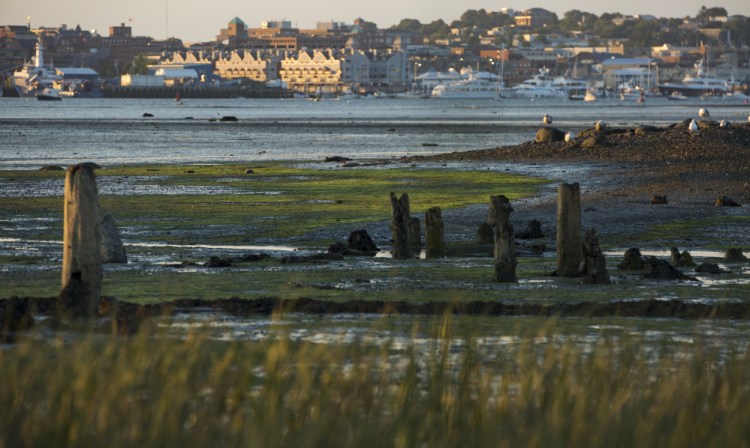Thick mats of slimy green algae are spreading over some tidal mudflats in the Portland area, raising concerns about nutrient levels in the water and the algal bloom’s impact on marine life.
Green algae now cover part of the muddy bottom of Portland’s Back Cove as well as parts of Mill Cove in South Portland. Friends of Casco Bay, the nonprofit organization that monitors conditions in the bay, is also looking into reports of algae blooms in Freeport, Brunswick and other coastal towns in the area.
While algal blooms are common – and natural – occurrences in Maine, the size of the blooms in Back Cove and Mill Cove is cause for concern, according to Friends of Casco Bay Executive Director Cathy Ramsdell.
This summer’s warm, sunny weather combined with a steady supply of food for the algae – especially nitrogen in stormwater or wastewater runoff – are likely driving the growth, although Ramsdell said the analysis is ongoing.

Algae blooms, like these in Mill Creek, are spreading throughout Casco Bay. Ben McCanna/Staff Photographer
“Our sense is that this isn’t one particular source (of nutrient pollution) that we can point to but, instead, is a situation where all of the background conditions make everything right for an outbreak,” Ramsdell said. “We are just seeing (conditions) setting things up for this algae to be able to go crazy.”
Ramsdell said she first caught a tinge of green in Portland’s Back Cove tidal area on July 7. By late July, areas of the cove were “dead green,” as seen in a picture of the cove taken via drone for Friends of Casco Bay.
The extent of the algae bloom in the Portland area pales in comparison to the situation capturing headlines in Florida, where algae as thick as pea soup or guacamole have clogged beaches and harbors for nearly 100 miles. Four entire counties in tourism-dependent South Florida are under “state of emergency” declarations because of the algae linked to polluted runoff in Lake Okeechobee.
But the type of algae found in Back Cove – in addition to being unsightly – can affect marine life buried in the mud or living in the water. Thick coats of algae can reduce oxygen levels as well as alter the acidity of the water and sediments.
Ramsdell said preliminary tests in Back Cove showed pH readings in mud varied dramatically depending on whether the sample areas were covered with algae or not.
Linda Bacon, a lake biologist with the Maine Department of Environmental Protection, said her office has received a large number of calls about a type of algae called “metaphyton” – which often resembles cotton candy – stuck to plants, docks or other objects in the water column.
“This year, conditions just promoted a lot of near-shore algal growth and plant growth,” Bacon said.
The good news, Bacon said, is that the metaphyton has “tied up” the phosphorus that might otherwise lead to the growth of planktonic algae that make the water look pea soup-greenish.
The combination of a warm winter followed by a cooler, windy spring also delayed the stratification of the water column in deep lakes or ponds. It’s that stratification – with a layer of warm water on top – that can lead to algal blooms in the type of hot, sunny conditions Maine has experienced of late.
In extreme cases, fish kills can result in Maine because there is not enough oxygen in the cooler, deeper waters where cold-dependent fish species such as trout live.
To thrive, algae typically need abundant sunlight for photosynthesis and a steady source of nutrients, such as nitrogen and phosphorus. Both of those nutrients end up in the water either through deposition from the air or through wastewater discharges and runoff from farm fields, lawns and golf courses treated with fertilizer.
The U.S. Environmental Protection Agency calls nutrient pollution from nitrogen and phosphorus “one of America’s most widespread, costly and challenging environmental problems.”
Some previous algal blooms in Casco Bay or elsewhere in Maine have been linked to specific sources of upstream pollution. This summer’s blooms are spread more widely, which Ramsdell said points to the need to address the overall amount of nitrogen and other nutrients flowing into Casco Bay from so-called “non-point source pollution” – such as fertilized lawns and farms.
“We have removed a lot of the obvious sources of nutrients or we regulate and control them now … and that has really helped us clean up water quality everywhere,” Ramsdell said. “But now we have all of these non-point sources of pollution that are more difficult to track.”
Ramsdell said she hopes such incidents can help educate homeowners to avoid or reduce the use of fertilizers.
“They make your grass grow, but they also make algae grow,” she said.
Send questions/comments to the editors.




Comments are no longer available on this story